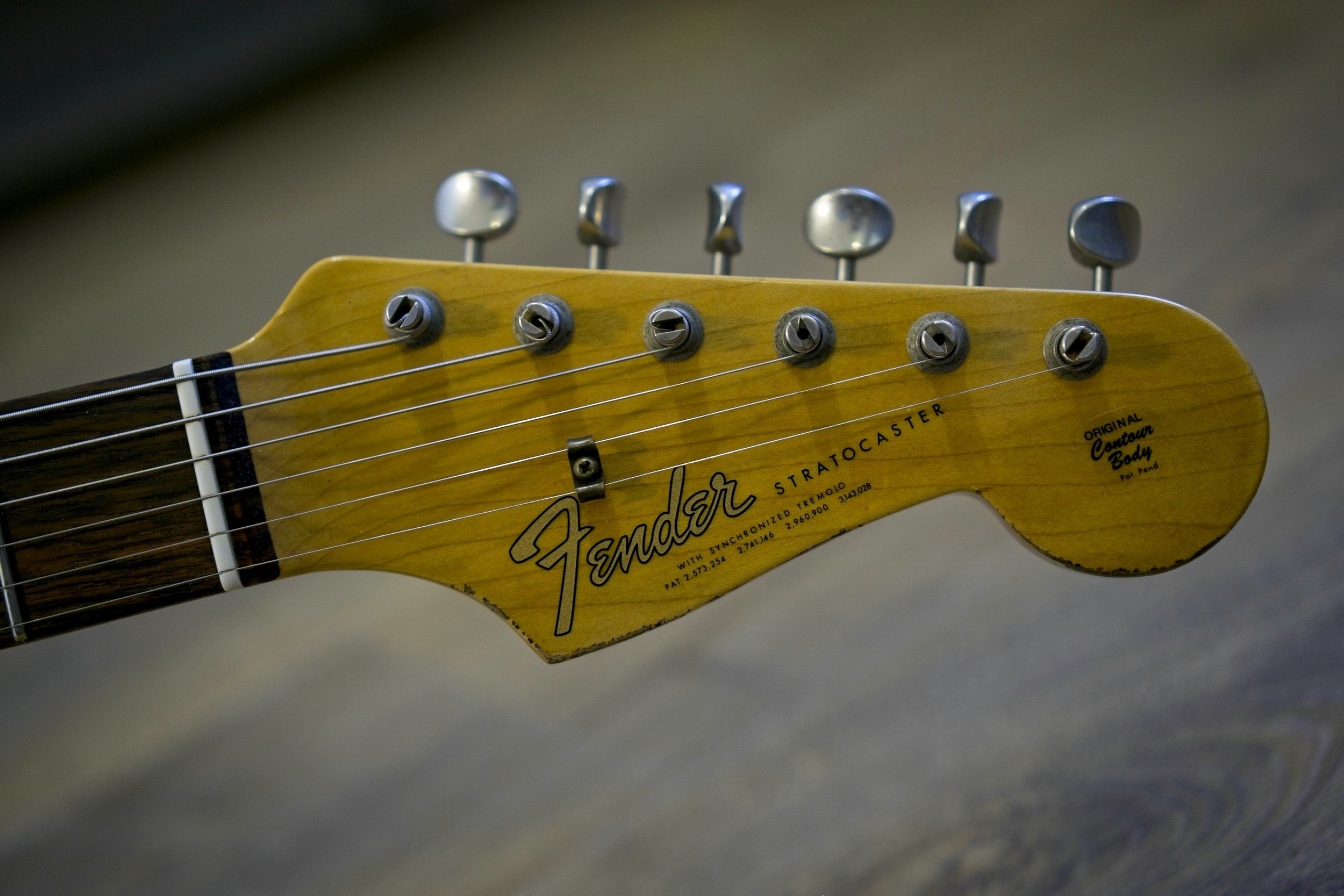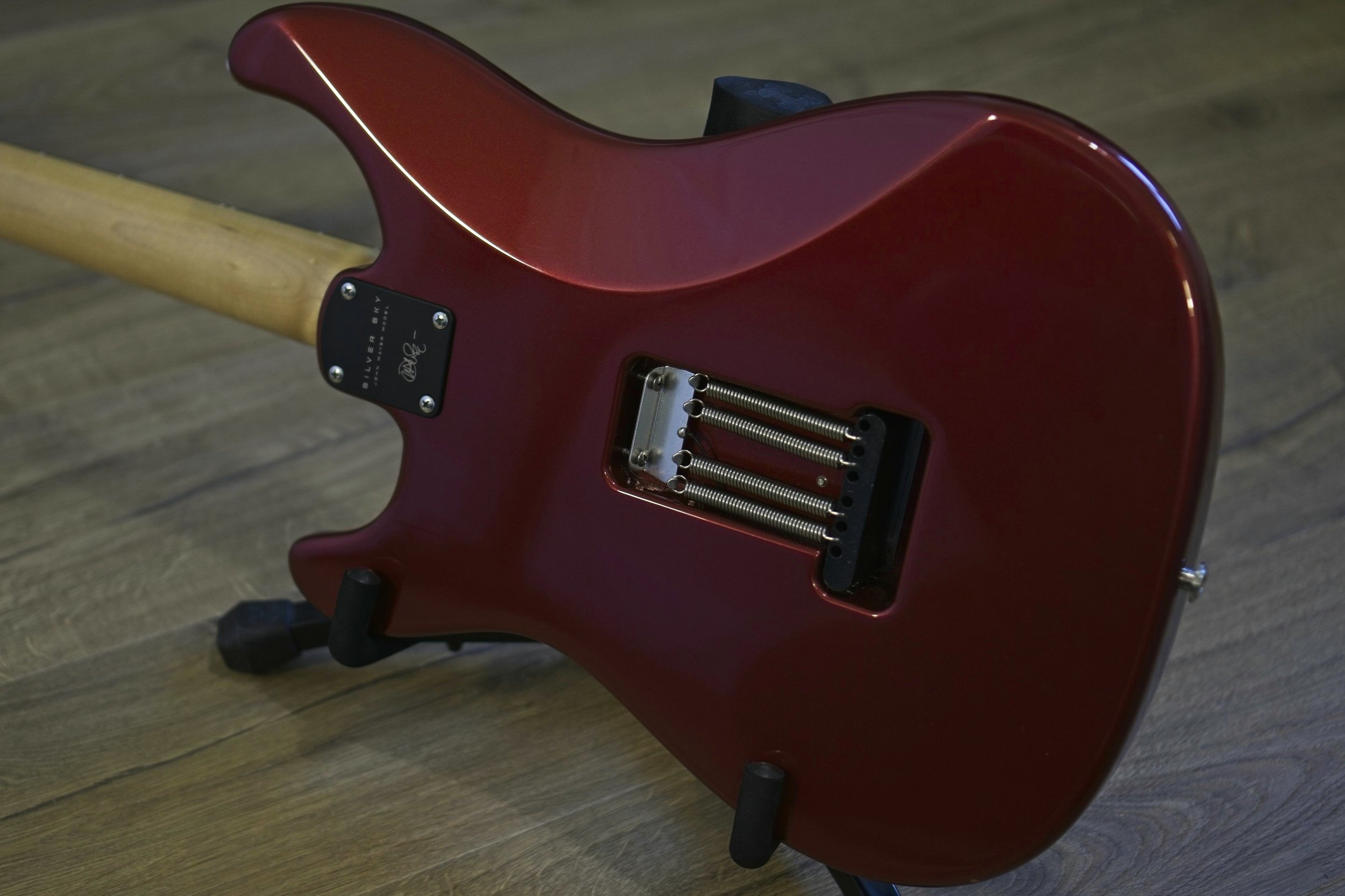PRS Silver Sky vs Fender Custom Shop Stratocaster
If it’s good enough for John Mayer...
- Light and balanced
- Fit and finish
- Great pickups
- Playability
- 7.25" fretboard not for everyone
- No hard case
- Every guitar is unique
- Pickups
- Playability
- Iconic design
- Expensive
The Silver Sky is one of the best-selling guitars at the moment, outselling every model sold by Fender. It is often compared to a vintage Stratocaster and even Paul Reed Smith regularly mentions how John Mayer’s signature guitar has the feel and tone of a 60s Stratocaster with superior consistency and reliability. Fender Custom Shop Strats come in many shapes and sizes, but today we will be comparing a Fender Custom Shop 64’ Stratocaster to the PRS Silver Sky.
At the time of writing, this particular Fender Custom Shop model can be purchased from Andertons for £5,199 and has a 3-month wait-list, although other Custom Shop models can be found for around £4,000. The Silver Sky is much cheaper and readily available at around £2,400 and can be found on sale for as little as £2,000.
Specs
Fender relicing aside, both guitars are very similar. Both feature a nitro-finished Alder body, maple C-shape neck and rosewood fingerboard. Both have a vintage six-point tremolo with vintage-style bent bridge saddles. Both guitars have two tone knobs, a volume control and a 5-way pickup selector.
The Fender has a single-piece maple neck. The Silver Sky has a scarf joint two-piece neck. Visually, it looks a bit odd, but the joint actually adds strength and stability to the neck.
Silver Sky headstock joint
The electronics are similar, but with some key differences. The Silver Sky features PRS JM 635 pickups, which are based on a ‘63/’64 Stratocaster with Alnico V. The Strat has Fender ‘65 Custom Shop single coil pickups with Alnico V magnets. The PRS pickups are wired out of phase in positions 2 and 4 to cancel out 60 cycle hum. The Fender is not wired to be hum-cancelling in positions 2 and 4. One is not necessarily better than the other and is a matter of personal preference. Both pickup sets are very similar in sound and output, measuring around 6kΩ.
The Silver Sky features a standard PRS 3+3 headstock with locking tuners and large tuning pegs. The Strat has a traditional 6-in-line headstock with vintage non-locking tuners. Functionally, the Silver Sky is better in this regard, but being a vintage reissue, the Stratocaster tuning pegs are period-correct.
Truss rod adjustment will be much easier on the Silver Sky, as it is available from the headstock. To adjust neck relief on the Strat, you will need to remove the neck, as was the case in 1964.
The Silver Sky has better upper fret access thanks to the deeper cutaway, although I can’t say I have ever struggled with upper fret access on the Strat.
Both guitars have medium nickel frets. The Silver Sky features a 7.25” fingerboard radius, while the Fender has a more modern 9.5” radius. This makes the Silver Sky slightly more comfortable for playing chords, while the Fender will excel at playing faster lead lines. That said, both guitars will have a pretty vintage feel. I can’t say I prefer one over the other in this regard.
There is no backplate on the Silver Sky, which gives it a sleeker, more modern appearance.
Fender Custom 64’Strat with backplate removed
PRS Silver Sky
Although the price will vary depending on the model, you can find Fender Custom Shops in almost any configuration and even custom order one to your exact specifications. The Custom Shop will also come with a Fender Hardshell case, certificate of authenticity and other Fender goodies, while the Silver Sky will come with a heavily padded gig bag.
Winner: Tie
Sound
Both guitars sound very similar and both sound great. The ‘65 Custom Shop pickups on the Strat have slightly higher output than the JM 635, but not by much. Neither guitar sounds brash or “ice-picky” when played clean, and both pair well with fuzz and overdrive.
There is, however, something special about the JM 635 pickups. It could be the pickups themselves or the way they pair with the bridge that PRS designed for the Silver Sky, but it just sounds a little fuller than the ‘64 Stratocaster. The neck pickup sounds very warm while retaining the single-coil sharpness and the bridge pickup sounds aggressive without being too harsh.
If you want to play like John Mayer, then the Silver Sky is definitely the way to go. If you want to sound more like Hendrix or Rory Gallagher, I would probably pick up the Stratocaster instead.
Winner: Tie
Playability
Both guitars are extremely comfortable to play. I have played many Custom Shop Strats and, for the most part, they all had that familiar worn-in feel. Fender offer various levels of ageing on their guitars. Most of them will have a sanded-down neck, but it’s not quite the same as leaving it unfinished or the satin necks on Fender’s Ultra guitars. It really feels like a guitar that has been played for 50 years.
Fender Custom Shop 64’ neck
Both guitars have vintage bridge saddles, which will poke at your hand if you try to palm mute, but that is not what they were designed for.
Silver Sky necks vary, depending on the fingerboard wood. For this comparison, we are using the rosewood version, which comes with a lacquered neck. I don't find it quite as comfortable as the sanded neck on the Fender, but that’s just personal preference. The fingerboards on both guitars have the same width, but the Fender has a rolled fingerboard (rounded on the edges), making the neck feel slimmer.
The neck on the maple fretboard Silver Sky, however, is very similar to the 64' Strat. The fingerboard is rolled, similar to the Strat, and the neck has a satin finish. It feels very similar to the sanded neck on the Fender.
The fretboard material itself makes little difference to the sound and playability, but I prefer the maple fretboard Silver Sky due to the satin neck and rolled fingerboard edges. John Mayer, however, seems to favour his rosewood Silver Sky in recent live performances. The hard case is, of course, more expensive, but I prefer the gig bag for practicality.
Winner: Tie
Build Quality
The build quality is flawless on both guitars. PRS are known for their unmatched consistency when producing their guitars. Every Silver Sky is almost exactly 3.2kg (7lbs). The first time I picked one up, it almost felt cheap due to how light it was, but I quickly got to appreciate the perfectly balanced weight distribution (this is likely why PRS opted for plastic tuning pegs). The fretwork and finish are also flawless. I have had my Silver Sky for four years now and it rarely requires any adjustment.
It's hard to evaluate the fit and finish of a reliced guitar, but I really like the look of my ‘64 Stratocaser. It has a candy red over gold finish with heavy relicing. The pickups, hardware and even the pickguard were aged to look consistent. The Fender stays in tune very well even with heavy use of the whammy bar. Everything just feels right.
The Strat weighs 3.6kg (8lbs), which is fairly typical, although you can find one closer to the weight of a Silver Sky if you shop around. Overall, I am extremely satisfied with the Custom Shop, but it doesn't quite have that perfectly balanced weight distribution, like the Silver Sky.
Looking at the wiring, you can see why the Fender could command a higher price. The Strat has perfectly cut cloth braided wires. The wiring on the Silver Sky, however, looks a bit messy. This has no real impact or reliability, but it’s nice to know you are getting that level of attention to detail with a Fender Custom Shop Guitar.
Winner: Tie
Fender Custom Shop wiring
PRS Silver Sky wiring
Price
Looking at the scores above the Silver Sky seems to be doing really well. It can easily go head-to-head with the much more expensive Stratocaster. Even a pre-owned Fender Custom Shop will be much more expensive than a Silver Sky. If price-to-performance is all you care about, then the Silver Sky is a significantly better deal.
It is, however, important to note that every Fender Custom Shop guitar is unique. Even production models will be made in much smaller numbers than the Silver Sky and each guitar will have a unique relic job. If you want to experience what it feels like to play a perfectly set-up 60 year old Stratocaster with all of its flaws, then Fender Custom Shop is your only option.
Winner: Tie
Botttom Line
Is the Silver Sky really as good as a Fender Custom Shop for a lot less money? Sort of. Despite the similarities, they aren't aimed at the same target audience.
The Silver Sky is a remarkable instrument and has all the modern appointments you would want as a professional musician, while keeping the sound and feel of a vintage guitar. John Mayer and Paul Reed Smith designed the perfect Stratocaster.
The Fender Custom Shop ‘64 Stratocaster, on the other hand, was made to represent the best of what Fender would have made back then. Playing it feels like playing a piece of history, quirks and all. Furthermore, you get the flexibility to order one exactly the way you want it. This flexibility comes at a cost.
Overall winner: Tie












